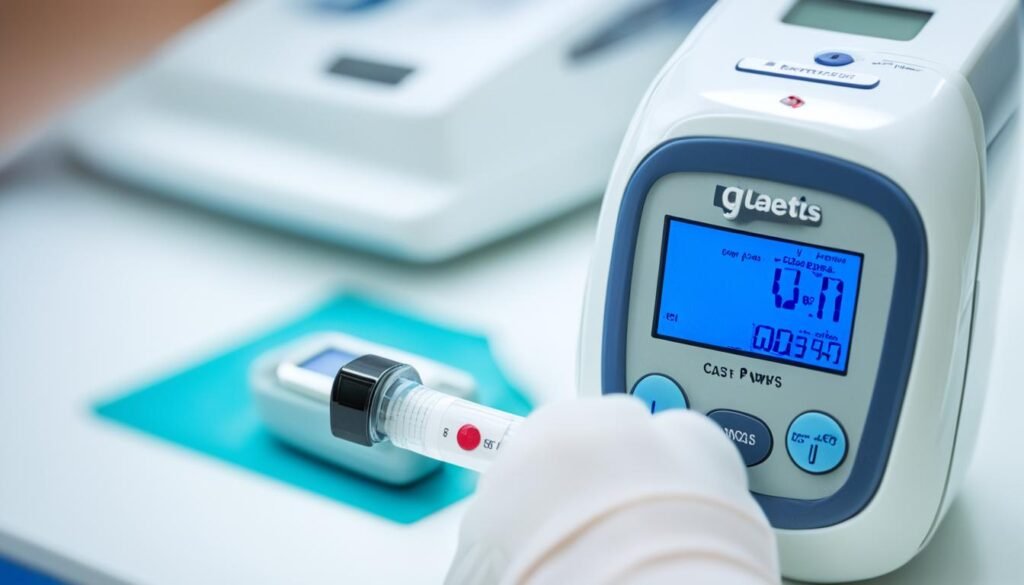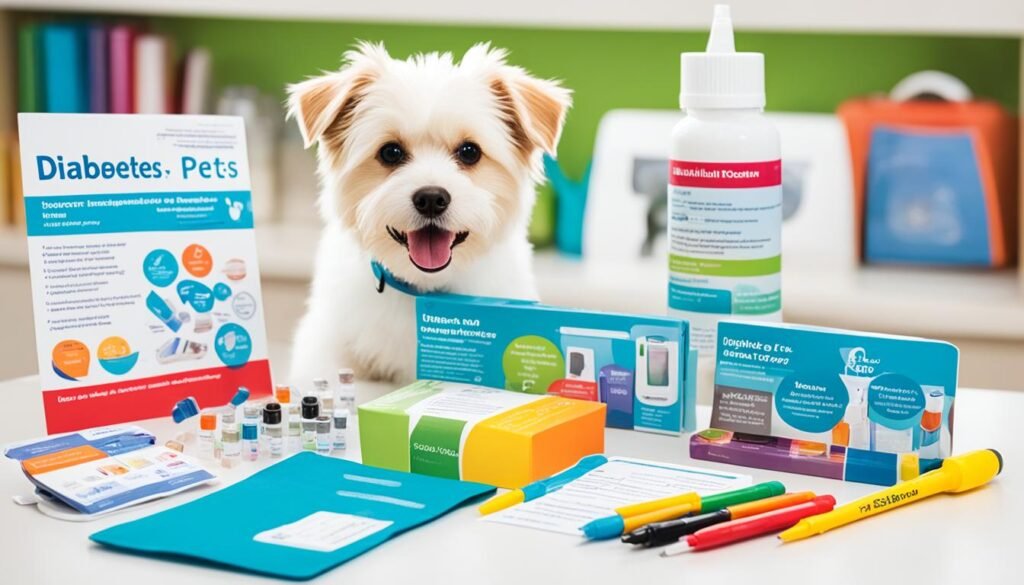
Welcome to our comprehensive guide on managing pet diabetes. If your furry friend has been diagnosed with diabetes, it’s essential to understand how to effectively care for their health and well-being. In this section, we will provide you with expert tips and advice on pet diabetes management, covering areas such as insulin injections, diet adjustments, glucose monitoring, and creating a stress-free home environment.
Pet diabetes can be a challenging condition to navigate, but with the right knowledge and strategies, you can ensure your pet’s quality of life remains high. By implementing the tips and recommendations shared in this guide, you can help your pet thrive and enjoy a healthier, happier life.
Understanding Pet Diabetes
Before diving into the management strategies, it’s crucial to understand what pet diabetes is and how it affects cats and dogs. Diabetes is a chronic condition characterized by the body’s inability to regulate blood sugar levels effectively. In pets, just like in humans, there are two types of diabetes: type 1 and type 2.
Type 1 diabetes occurs when the pancreas fails to produce enough insulin, a hormone responsible for regulating glucose levels in the body. This type is more common in dogs than in cats.
Type 2 diabetes is primarily seen in overweight or obese cats. In this case, the pancreas may produce insulin, but the body becomes resistant to its effects, leading to elevated blood sugar levels.
Regardless of the type, both cats and dogs show similar symptoms when suffering from pet diabetes, including increased thirst, frequent urination, weight loss despite a healthy appetite, and lethargy. If you notice these signs in your pet, it’s essential to consult a veterinarian for a proper diagnosis.
“Diabetes is a serious condition that requires proper treatment and management to ensure the well-being of our furry companions.”
Once diagnosed with diabetes, cats and dogs require immediate treatment to control their blood sugar levels. The primary treatment for pet diabetes includes:
- Dietary adjustments: A well-balanced diet low in carbohydrates and high in protein is crucial for managing diabetes in pets. This can help regulate blood sugar levels and support overall health.
- Insulin injections: Just like humans, pets with diabetes often require insulin injections to maintain stable blood sugar levels. These injections must be administered at regular intervals, as prescribed by your veterinarian.
- Regular exercise: Physical activity is essential for maintaining a healthy weight and managing blood sugar levels. Consult your veterinarian to determine the appropriate exercise routine for your diabetic pet.
- Glucose monitoring: Regular monitoring of your pet’s blood glucose levels is vital to ensure effective diabetes management. This can be done at home using a portable glucose meter.
With proper management and care, pets with diabetes can lead fulfilling lives. In the following sections, we will delve deeper into each aspect of pet diabetes management, from insulin administration to glucose monitoring and dietary considerations.
Insulin Management for Pets
When it comes to effectively managing pet diabetes, insulin plays a crucial role in regulating blood sugar levels. Understanding how to administer insulin injections, the different types of insulin available, and maintaining a proper injection routine is essential for the well-being of your diabetic pet.
Administering Insulin Injections
Administering insulin injections may initially seem daunting, but with practice and guidance, it can become a routine part of your pet’s diabetes management. Here are some steps to follow:
- Start by gathering all the necessary supplies, including insulin, syringes, and alcohol wipes.
- Choose an injection site, such as the scruff of the neck or the flank, and clean the area with an alcohol wipe.
- Fill the syringe with the prescribed dose of insulin, ensuring that there are no air bubbles.
- Gently pinch the skin at the injection site to create a small tent-like fold.
- Insert the needle into the fold of skin at a 45-degree angle, and slowly push the plunger to administer the insulin.
- Withdraw the needle at the same angle and dispose of it safely.
It’s essential to consult with your veterinarian for specific instructions tailored to your pet’s needs. They can teach you the proper injection technique and provide guidance on proper handling and disposal of needles and supplies.
Understanding Insulin Types
There are various types of insulin available for treating pet diabetes. The most common types include:
| Type | Description |
|---|---|
| Short-Acting Insulin | Provides rapid relief and lasts for a short duration. It is ideal for managing post-meal blood sugar spikes. |
| Intermediate-Acting Insulin | Takes longer to start working, but its effects last longer. It helps regulate blood sugar between meals and overnight. |
| Long-Acting Insulin | Provides a continuous release of insulin throughout the day, mimicking the body’s natural production. It helps maintain stable blood sugar levels. |
“Proper understanding of insulin types and their timing is crucial in managing your pet’s diabetes effectively.”
Monitoring Dosage and Injection Routine
Regularly monitoring your pet’s insulin dosage and maintaining a consistent injection routine are vital for successful diabetes management. Here are some key considerations:
- Work closely with your veterinarian to determine the appropriate insulin dosage for your pet.
- Monitor your pet’s blood glucose levels regularly to assess the effectiveness of the insulin dosage.
- Keep a detailed record of your pet’s insulin injections, including the date, time, dosage, and any observed changes in their behavior or blood sugar levels.
- Follow a consistent schedule for administering insulin to maintain stable blood sugar levels.
- Notify your veterinarian if you notice any significant changes or irregularities in your pet’s response to insulin.
Remember, managing pet diabetes at home requires close collaboration with your veterinarian. They will provide personalized guidance based on your pet’s specific needs and help you navigate any challenges that may arise.
Optimal Glucose Monitoring for Pets
Regular glucose monitoring is crucial for effectively managing pet diabetes. By monitoring your pet’s glucose levels, you can assess their response to treatment and make necessary adjustments to their management plan. In this section, we will explore different methods and devices available for at-home glucose monitoring, empowering you to take control of your pet’s health.
When it comes to glucose monitoring for pets, two main options are commonly used: blood glucose meters and continuous glucose monitoring (CGM) systems. Blood glucose meters are handheld devices that require a small blood sample from your pet for testing. CGM systems, on the other hand, provide continuous glucose readings and eliminate the need for frequent blood samples.
When using a blood glucose meter, it’s important to follow the manufacturer’s instructions to obtain accurate results. Remember to use a fresh lancet for each blood sample and properly handle and store the test strips. Regularly calibrating your meter is crucial to ensure accurate readings.
If you prefer a non-invasive method, a CGM system may be a suitable option. These systems use a small sensor attached to your pet’s skin to continuously measure glucose levels. The sensor sends the readings to a receiver or smartphone app, allowing you to monitor glucose trends over time.

Interpreting Glucose Readings
Monitoring your pet’s glucose levels is essential for making informed decisions about their treatment plan. It is crucial to work closely with your veterinarian to understand the optimal glucose range for your pet and interpret the readings correctly.
Generally, blood glucose levels should remain within a specific target range for your pet’s well-being. High glucose levels (hyperglycemia) may indicate insulin resistance or insufficient insulin dosage, while low glucose levels (hypoglycemia) may suggest an overdose of insulin or insufficient food intake.
By consistently monitoring your pet’s glucose readings, you can identify patterns and make necessary adjustments to their insulin dosage, diet, or exercise routine. Documenting these readings in a logbook or using a mobile app can help you and your veterinarian track your pet’s progress and make informed decisions together.
Effective Glucose Monitoring Tips
- Stay consistent: Establish a regular monitoring schedule, ensuring you test your pet’s glucose levels at the same time each day.
- Minimize stress: Create a calm and soothing environment for glucose monitoring sessions, as stress can affect glucose levels.
- Handle with care: Properly store and handle your monitoring devices and supplies to ensure accurate results.
- Keep a record: Maintain a logbook or use a mobile app to record your pet’s glucose readings, treatment adjustments, and any notable observations.
Remember, glucose monitoring is an essential tool in managing pet diabetes. It empowers you to make timely adjustments to your pet’s management plan, ensuring they live a happy and healthy life.
Pet Diabetes Diet: What to Feed and Avoid
Nutrition plays a vital role in managing your pet’s diabetes. A well-balanced diet can help regulate blood sugar levels and support your pet’s overall health and glycemic control. In this section, we will discuss the ideal diet for diabetic pets, including the types of food to feed and those to avoid.
What to Feed:
- High-quality protein sources: Choose lean meats such as chicken, turkey, and fish for your pet’s diet. These protein sources are low in carbohydrates and help maintain muscle mass.
- Fiber-rich foods: Opt for fiber-rich foods like vegetables and whole grains. These can help regulate your pet’s blood sugar levels and promote digestion.
- Complex carbohydrates: Include complex carbohydrates like sweet potatoes and quinoa in your pet’s diet. These carbohydrates are slow-releasing and provide a steady source of energy.
- Healthy fats: Incorporate omega-3 fatty acids from sources like fish oil into your pet’s diet. These fats offer numerous health benefits, including reducing inflammation.
Foods to Avoid:
- High-carbohydrate foods: Avoid feeding your pet foods that are high in carbohydrates, such as white rice, bread, and sugary treats. These can cause spikes in blood sugar levels.
- Fatty foods: Limit the intake of fatty foods like fried meats and high-fat treats. Excessive fat consumption can lead to weight gain and insulin imbalances.
- Sweetened beverages: Steer clear of sweetened drinks or flavored water. These contain added sugars that can negatively affect your pet’s blood sugar levels.
- Junk food and processed snacks: Avoid giving your pet junk food and processed snacks, including chips, candies, and cookies. These foods are often high in unhealthy fats and sugars.
Creating a Balanced Diet Plan
Designing a balanced diet plan for your diabetic pet can be challenging. It’s essential to work closely with your veterinarian to develop a personalized diet that meets your pet’s specific needs. Your vet can recommend the appropriate portion sizes and frequency of feeding based on your pet’s weight, age, and activity level.
In addition to diet, regular exercise and weight management are crucial for your pet’s overall well-being. Consult with your vet to determine the appropriate exercise routine for your diabetic pet, taking into account their physical capabilities and any other health conditions they may have.
Remember, consistency is key when managing your pet’s diabetes. Stick to the recommended diet plan, monitor their blood glucose levels regularly, and make adjustments as needed under the guidance of your veterinarian.

Managing Pet Diabetes at Home
When it comes to managing pet diabetes, creating a supportive and structured environment at home is crucial for your pet’s health and wellbeing. By following these practical tips and strategies, you can ensure that your furry friend thrives while living with diabetes.
Establishing a Consistent Routine
Consistency is key when it comes to managing pet diabetes. Establish a regular schedule for feeding, administering medication, and exercise. This routine will help regulate your pet’s blood sugar levels and maintain stability. Stick to the same time every day for meals and insulin injections to create a sense of predictability.
Maintaining Regular Exercise
Regular exercise is important for managing your pet’s diabetes. Engaging in activities like daily walks or playtime can help control weight, regulate blood sugar levels, and improve insulin sensitivity. Consult with your veterinarian to determine an appropriate exercise routine based on your pet’s age, breed, and overall health.
Providing a Stress-Free Environment
Stress can disrupt your pet’s blood sugar levels and overall health. Create a calm and peaceful environment at home by minimizing loud noises, avoiding sudden changes, and providing a safe space where your pet can relax. Monitoring stress levels and managing them effectively can contribute to better glucose control.
“By establishing a consistent routine, maintaining regular exercise, and providing a stress-free environment, you can play an active role in managing your pet’s diabetes and enhancing their overall quality of life.” – Dr. Sarah Thompson, DVM
Monitoring and Communication
Regularly monitor your pet’s blood sugar levels, weight, and overall health to stay ahead of any potential complications. Keep a record of these readings and share them with your veterinarian during regular check-ups. Open communication with your vet will help you make any necessary adjustments to your pet’s management plan.
Creating a Supportive Network
Don’t hesitate to reach out to fellow pet owners who are managing diabetes in their pets. Join online communities or support groups where you can share experiences, gain insights, and find emotional support. Remember, you’re not alone in this journey, and others may have valuable information to offer.

| Tip | Benefit |
|---|---|
| Create a Consistent Routine | Regulates blood sugar levels, maintains stability |
| Maintain Regular Exercise | Control weight, regulate blood sugar levels, improve insulin sensitivity |
| Provide a Stress-Free Environment | Prevent disruptions in blood sugar levels, promote overall health |
| Monitor and Communicate | Stay proactive in managing your pet’s health, make informed decisions |
| Create a Supportive Network | Gain insights, find emotional support from fellow pet owners |
Pet Diabetes Resources
Accessing reliable resources and support is essential for effectively managing your pet’s diabetes. Whether you’re seeking information, guidance, or a community of like-minded pet owners, these pet diabetes resources can provide the help you need. Explore the following websites, online communities, and vet-approved sources to assist you throughout your pet’s diabetes management journey:
1. American Animal Hospital Association (AAHA)
The AAHA provides a wealth of information on various pet health topics, including diabetes management. Their website offers articles, guidelines, and resources to help you understand and navigate your pet’s diabetes diagnosis.
2. Pet Diabetes Community

Join the Pet Diabetes Community, an online forum where pet owners share experiences, knowledge, and support related to managing pet diabetes. Connect with others who understand the challenges and triumphs of caring for a diabetic pet.
3. Veterinary Partner
Veterinary Partner is an online resource that provides reliable information on various pet health conditions. Visit their website to find in-depth articles, research-based information, and expert advice on managing pet diabetes.
4. American Association of Feline Practitioners (AAFP)
If you have a diabetic cat, the AAFP website is a valuable resource. They offer guidelines and resources specific to feline diabetes management, helping you provide the best care for your beloved feline companion.
| Resource | Description |
|---|---|
| VetApprovedRx | A trusted online source for pet diabetes medications and supplies. They offer a wide range of products to support your pet’s diabetes management needs. |
| Pet Diabetes Tracker App | A mobile app designed to help you track and manage your pet’s diabetes. Monitor glucose levels, insulin doses, and other vital information in one convenient place. |
| American Diabetes Association | While primarily focused on human diabetes, their website offers valuable resources that can be applied to pet diabetes management, such as meal planning and exercise recommendations. |
Remember, always consult with your veterinarian for personalized advice and guidance tailored to your pet’s unique needs. These resources can supplement your vet’s recommendations and provide additional insights into managing your pet’s diabetes.
Conclusion: Ensuring a Healthier, Happier Pet
In conclusion, proactive pet diabetes management is paramount for the well-being of your furry friend. By effectively managing insulin, monitoring glucose levels, maintaining a suitable diet, and establishing a consistent home routine, you can significantly improve your pet’s overall health and quality of life.
Insulin management plays a crucial role in controlling diabetes in pets. Whether it’s administering insulin injections or understanding the different types of insulin available, staying diligent in this aspect is essential. Remember to work closely with your veterinarian to determine the right dosage and ensure a proper injection routine.
Regular glucose monitoring is another vital element of pet diabetes management. By using appropriate monitoring methods and devices, you can closely track your pet’s glucose levels at home. Carefully interpreting these readings and making necessary adjustments to their management plan can help maintain optimal glycemic control.
Additionally, crafting a suitable diet for your diabetic pet is vital. Consult with your veterinarian to determine the best options for their specific needs. Avoiding high-carbohydrate foods and focusing on balanced nutrition can help regulate your pet’s blood sugar levels. Provide them with a well-rounded diet that supports their overall health and keeps their diabetes in check.
Lastly, establishing a consistent home routine can greatly benefit your pet’s diabetes management. Create a stress-free environment, maintain regular exercise, and ensure timely administration of medication and meals. These steps promote stability and help your furry companion thrive.
By prioritizing insulin management, glucose monitoring, diet, and a consistent home routine, you can ensure a healthier, happier life for your beloved pet. Remember to seek advice from your veterinarian, access reliable pet diabetes resources, and continue to learn and adapt as you navigate your pet’s diabetic journey.
FAQ
What is pet diabetes?
How is pet diabetes diagnosed?
What are the common symptoms of pet diabetes?
Can pet diabetes be managed at home?
How do I administer insulin injections to my pet?
What should I feed my pet with diabetes?
How often should I monitor my pet’s glucose levels?
Are there any resources available for managing pet diabetes?
RELATED POSTS
View all


